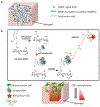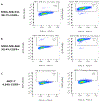Photo-immobilized EGF chemical gradients differentially impact breast cancer cell invasion and drug response in defined 3D hydrogels
- PMID: 29452913
- PMCID: PMC6066187
- DOI: 10.1016/j.biomaterials.2018.01.032
Photo-immobilized EGF chemical gradients differentially impact breast cancer cell invasion and drug response in defined 3D hydrogels
Abstract
Breast cancer cell invasion is influenced by growth factor concentration gradients in the tumor microenvironment. However, studying the influence of growth factor gradients on breast cancer cell invasion is challenging due to both the complexities of in vivo models and the difficulties in recapitulating the tumor microenvironment with defined gradients using in vitro models. A defined hyaluronic acid (HA)-based hydrogel crosslinked with matrix metalloproteinase (MMP) cleavable peptides and modified with multiphoton labile nitrodibenzofuran (NDBF) was synthesized to photochemically immobilize epidermal growth factor (EGF) gradients. We demonstrate that EGF gradients can differentially influence breast cancer cell invasion and drug response in cell lines with different EGF receptor (EGFR) expression levels. Photopatterned EGF gradients increase the invasion of moderate EGFR expressing MDA-MB-231 cells, reduce invasion of high EGFR expressing MDA-MB-468 cells, and have no effect on invasion of low EGFR-expressing MCF-7 cells. We evaluate MDA-MB-231 and MDA-MB-468 cell response to the clinically tested EGFR inhibitor, cetuximab. Interestingly, the cellular response to cetuximab is completely different on the EGF gradient hydrogels: cetuximab decreases MDA-MB-231 cell invasion but increases MDA-MB-468 cell invasion and cell number, thus demonstrating the importance of including cell-microenvironment interactions when evaluating drug targets.
Keywords: Breast cancer; EGF; Gradients; Hydrogels; Invasion.
Copyright © 2018 Elsevier Ltd. All rights reserved.
Figures








Similar articles
-
Taiwan cobra cardiotoxin III suppresses EGF/EGFR-mediated epithelial-to-mesenchymal transition and invasion of human breast cancer MDA-MB-231 cells.Toxicon. 2016 Mar 1;111:108-20. doi: 10.1016/j.toxicon.2016.01.051. Epub 2016 Jan 14. Toxicon. 2016. PMID: 26774845
-
A double-network poly(Nɛ-acryloyl L-lysine)/hyaluronic acid hydrogel as a mimic of the breast tumor microenvironment.Acta Biomater. 2016 Mar;33:131-41. doi: 10.1016/j.actbio.2016.01.027. Epub 2016 Jan 21. Acta Biomater. 2016. PMID: 26805429
-
Structurally decoupled hyaluronic acid hydrogels for studying matrix metalloproteinase-mediated invasion of metastatic breast cancer cells.Int J Biol Macromol. 2024 Oct;277(Pt 4):134493. doi: 10.1016/j.ijbiomac.2024.134493. Epub 2024 Aug 5. Int J Biol Macromol. 2024. PMID: 39111478
-
Characterization of EGF-guided MDA-MB-231 cell chemotaxis in vitro using a physiological and highly sensitive assay system.PLoS One. 2018 Sep 13;13(9):e0203040. doi: 10.1371/journal.pone.0203040. eCollection 2018. PLoS One. 2018. PMID: 30212492 Free PMC article.
-
Activation of H-Ras and Rac1 correlates with epidermal growth factor-induced invasion in Hs578T and MDA-MB-231 breast carcinoma cells.Biochem Biophys Res Commun. 2011 Mar 4;406(1):25-9. doi: 10.1016/j.bbrc.2011.01.092. Epub 2011 Jan 31. Biochem Biophys Res Commun. 2011. PMID: 21281602
Cited by
-
Two-photon uncaging of bioactive thiols in live cells at wavelengths above 800 nm.Org Biomol Chem. 2021 Mar 18;19(10):2213-2223. doi: 10.1039/d0ob01986k. Org Biomol Chem. 2021. PMID: 33349821 Free PMC article.
-
Mesenchymal stromal cell activation by breast cancer secretomes in bioengineered 3D microenvironments.Life Sci Alliance. 2019 Jun 3;2(3):e201900304. doi: 10.26508/lsa.201900304. Print 2019 Jun. Life Sci Alliance. 2019. PMID: 31160380 Free PMC article.
-
Nanostructured Biomaterials in 3D Tumor Tissue Engineering Scaffolds: Regenerative Medicine and Immunotherapies.Int J Mol Sci. 2024 May 16;25(10):5414. doi: 10.3390/ijms25105414. Int J Mol Sci. 2024. PMID: 38791452 Free PMC article. Review.
-
Exploring New Dimensions of Tumor Heterogeneity: The Application of Single Cell Analysis to Organoid-Based 3D In Vitro Models.Adv Healthc Mater. 2023 Oct;12(26):e2300903. doi: 10.1002/adhm.202300903. Epub 2023 Aug 27. Adv Healthc Mater. 2023. PMID: 37589373 Free PMC article. Review.
-
Breast cancer models: Engineering the tumor microenvironment.Acta Biomater. 2020 Apr 1;106:1-21. doi: 10.1016/j.actbio.2020.02.006. Epub 2020 Feb 9. Acta Biomater. 2020. PMID: 32045679 Free PMC article. Review.
References
-
- Muller A, Homey B, Soto H, Ge N, Catron D, Buchanan ME, et al., Involvement of chemokine receptors in breast cancer metastasis, Nature. 410 (2001) 50–56. - PubMed
Publication types
MeSH terms
Substances
Grants and funding
LinkOut - more resources
Full Text Sources
Other Literature Sources
Medical
Research Materials
Miscellaneous

